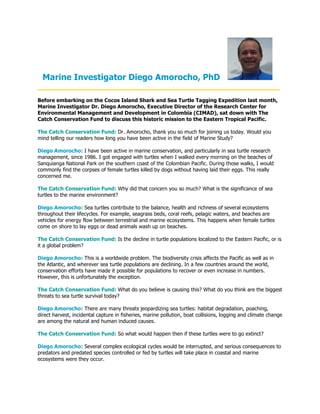
Marine Investigator Dr Diego Amorocho Discusses Sea Turtle Conservation
- 1. Marine Investigator Diego Amorocho, PhD ____________________________________________________ Before embarking on the Cocos Island Shark and Sea Turtle Tagging Expedition last month, Marine Investigator Dr. Diego Amorocho, Executive Director of the Research Center for Environmental Management and Development in Colombia (CIMAD), sat down with The Catch Conservation Fund to discuss this historic mission to the Eastern Tropical Pacific. The Catch Conservation Fund: Dr. Amorocho, thank you so much for joining us today. Would you mind telling our readers how long you have been active in the field of Marine Study? Diego Amorocho: I have been active in marine conservation, and particularly in sea turtle research management, since 1986. I got engaged with turtles when I walked every morning on the beaches of Sanquianga National Park on the southern coast of the Colombian Pacific. During those walks, I would commonly find the corpses of female turtles killed by dogs without having laid their eggs. This really concerned me. The Catch Conservation Fund: Why did that concern you so much? What is the significance of sea turtles to the marine environment? Diego Amorocho: Sea turtles contribute to the balance, health and richness of several ecosystems throughout their lifecycles. For example, seagrass beds, coral reefs, pelagic waters, and beaches are vehicles for energy flow between terrestrial and marine ecosystems. This happens when female turtles come on shore to lay eggs or dead animals wash up on beaches. The Catch Conservation Fund: Is the decline in turtle populations localized to the Eastern Pacific, or is it a global problem? Diego Amorocho: This is a worldwide problem. The biodiversity crisis affects the Pacific as well as in the Atlantic, and wherever sea turtle populations are declining. In a few countries around the world, conservation efforts have made it possible for populations to recover or even increase in numbers. However, this is unfortunately the exception. The Catch Conservation Fund: What do you believe is causing this? What do you think are the biggest threats to sea turtle survival today? Diego Amorocho: There are many threats jeopardizing sea turtles: habitat degradation, poaching, direct harvest, incidental capture in fisheries, marine pollution, boat collisions, logging and climate change are among the natural and human induced causes. The Catch Conservation Fund: So what would happen then if these turtles were to go extinct? Diego Amorocho: Several complex ecological cycles would be interrupted, and serious consequences to predators and predated species controlled or fed by turtles will take place in coastal and marine ecosystems were they occur.
- 2. The Catch Conservation Fund: That brings us to your upcoming mission in the Pacific. What are the goals of the Cocos Island Shark and Sea Turtle Tagging Expedition? Diego Amorocho: Our goal is to contribute knowledge about these animals’ migratory movements along the Eastern Tropical Pacific Marine Corridor that encompasses the islands of Cocos in Costa Rica, Coiba in Panama, Gorgona and Malpelo in Colombia, and Galapagos in Ecuador. Ultimately, we would like to create regional coordination for the conservation management of migratory and threatened species such as sharks, turtles and whales. The Catch Conservation Fund: So that is why you are putting satellite tags on 4 Green Turtles? Diego Amorocho: For conservation purposes it is important to find out if these turtles remain in Costa Rican waters or migrate to other countries included within the Eastern Tropical Pacific Marine Corridor. We will learn more about their diving time, daily breathing cycles and surface permanence. We will also be mapping their movements to find out where each animal spends the most time. The Catch Conservation Fund: Project Kaisei is taking place right now in the North Pacific Gyre. What is the impact of marine plastic debris on the sea turtles? Diego Amorocho: Yes, this is a major issue for sea turtle conservation everywhere. Plastic has been found in 99% of assessed turtles during our digestive and nutritional research trials. The Catch Conservation Fund: What can the average person reading this do to reverse these trends in our oceans, and help bolster falling marine populations? Diego Amorocho: The biggest thing everyone can do is to reduce unnecessary consumption. Don’t litter. Reuse plastic containers. Common sense is usually the best guide. Each of us can make a difference by doing our part to take care of our unique planet. The Catch Conservation Fund: Thank you for joining us to answer all of our questions this afternoon. Good luck with your mission to Cocos Island. Diego Amorocho: You’re very welcome. It’s been a pleasure talking with you about these important issues, and I hope your readers get a lot out of our discussion. Thank you for reading our interview with Marine Investigator Dr. Diego Amorocho. The Catch Conservation Fund is a 501(c)(3) nonprofit organization. Your tax-deductible donation helps us protect endangered sea turtles and sharks around the world. Find out more about global threats to shark and sea turtle survival and what you can do to help by visiting the following websites: www.pretoma.org www.seaturtles.org www.migramar.org www.cimad.org www.tirn.net ____________________________________________________ The Catch Conservation Fund ● 788 Holiday Road ● McCormick, SC 29835 www.catchconservation.com
